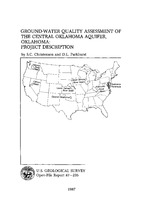In April 1986, the U.S. Geological Survey began a pilot program to assess the quality of the Nation's surface-water and ground-water resources. The program, known as the National Water-Quality Assessment (NAWQA) program, is designed to acquire and interpret information about a variety of water-quality issues.
The Central Oklahoma aquifer project is one of three ground-water pilot projects that have been started. The NAWQA program also incudes four surface-water pilot projects. The Central Oklahoma aquifer project, as part of the pilot NAWQA program, will develop and test methods for performing assessments of ground-water quality. The objectives of the Central Oklahoma aquifer assessment are: (1) To investigate regional ground-water quality throughout the aquifer in the manner consistent with the other pilot ground-water projects, emphasizing the occurrence and distribution of potentially toxic substances in ground water, including trace elements, organic compounds, and radioactive constituents; (2) to describe relations between ground-water quality, land use, hydrogeology, and other pertinent factors; and (3) to provide a general description of the location, nature, and possible causes of selected prevalent water-quality problems within the study unit; and (4) to describe the potential for water-quality degradation of ground-water zones within the study unit.
The Central Oklahoma aquifer, which includes in descending order the Garber Sandstone and Wellington Formation, the Chase Group, the Council Grove Group, the Admire Group, and overlying alluvium and terrace deposits, underlies about 3,000 square miles of central Oklahoma and is used extensively for municipal, industrial, commercial, and domestic water supplies. The aquifer was selected for study by the NAWQA program because it is a major source for water supplies in central Oklahoma and because it has several known or suspected water-quality problems. Known problems include concentrations of arsenic, chromium, selenium, and gross-alpha activity that exceed drinking-water standards. Suspected problems include possible contamination of the aquifer by oil-field brines and drilling fluids, pesticides, industrial chemicals, septic-tank effluent, fertilizers, and leakage from sewage systems and underground tanks used for storage of hydrocarbons.
There are four major components of the Central Oklahoma aquifer project. The first component is the collection and analysis of existing information, including chemical, hydrologic, and land-use data. The second component is the geohydrologic and geochemical investigations of the aquifer flow system. The third component is the sampling for a wide variety of inorganic, organic, and radioactive constituents as part a regional survey that will produce a consistent set of data among all ground-water pilot projects. These data can be used to: (1) Define regional ground-water quality within the Central Oklahoma aquifer, and (2) compare water quality in the Central Oklahoma aquifer to the water quality in the other ground-water study units of the NAWQA program. The fourth component is topical studies that will address, in more detail, some of the major water-quality issues pertaining to the aquifer.


